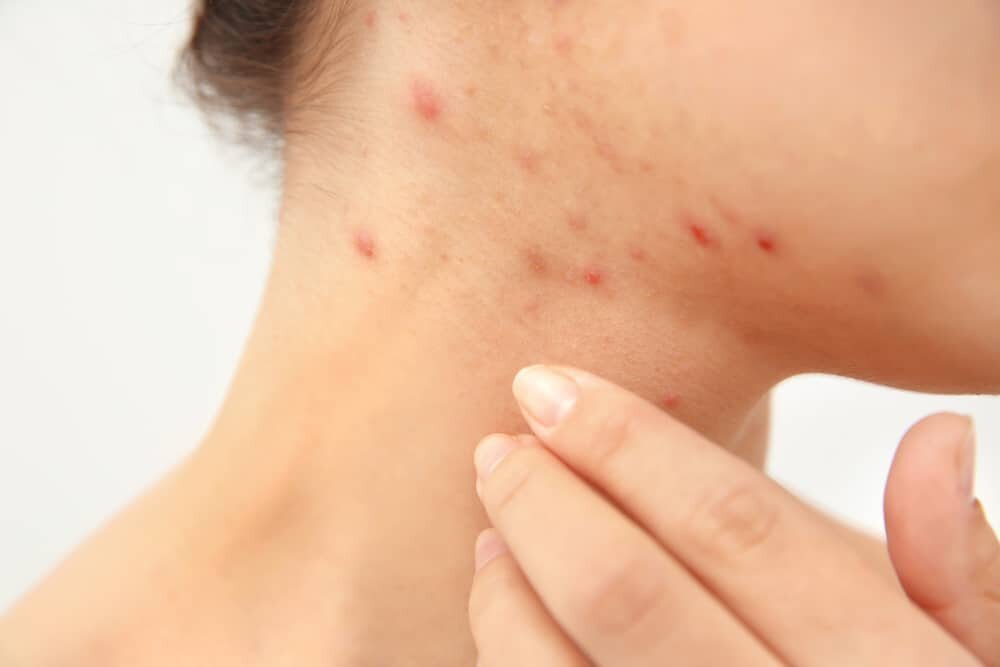Scabies is an infestation characterized by large sections of itchy skin, being caused by a tiny microscopic mite which burrows under the skin. This mite goes by the name Sarcoptes scabiei, and is the cause of this infestation (not infection).
Scabies is highly contagious, in the sense that it spreads easily from person to person via direct contact, or from exposure to linens where the mite may have also taken residence or fallen off of its human host.
Even though the infestation can be very annoying and uncomfortable, it does not pose an immediate health risk to you.
Symptoms of Scabies
The first time you develop a scabies infestation, it may take as long as six weeks for symptoms to first manifest. However, in the case of a reinfection, symptoms may occur in as little as two days, owing to the role the immune system plays in detecting the mites.
In general, there are known symptoms that occur regardless of if this is the first time, or fifth time you develop such an infestation. These include:
- Frequent itching, typically worsened at night when the mites may actively come out of their safe burrows under the skin or when they dig deeper tracks.
- Tiny tracks that can be seen on the skin, in addition to numerous bumps or tiny blisters.
Occurrence Of Tracks/Burrows
Tracks are most visible on the areas of skin that create folds. Common areas of highest mite density include:
- Armpits
- Spaces between each finger
- Around your waist
- The inner sides of your wrists
- Your inner elbow
- Buttocks
- Scrotum
- Behind the knees
- Below the breasts
- The scalp, soles of the feet or palms of the hands are also possible if children develop an infestation.
Rarely, some persons may develop Norwegian scabies infestation, which causes severe crusting of the skin, with these crusts containing thousands of scabies mites and their eggs. It is much more contagious that the type of scabies most persons develop, being more likely to occur in persons with compromised immune systems.
Causes of Scabies
While it has been established that scabies infestation is caused by mites, it is more correct to explain the ways in which scabies may be spread, thus leading to an infestation.



It is likely to occur via the following ways:
- From skin to skin contact such as casually hugging, shaking hands or being in close proximity to another person with a current infestation.
- Sharing of clothing, towels or bed linens used by someone with a scabies infestation.
- Window blinds – mites can live on window blinds or drapes even when you think you have sufficiently cleansed the room from adult mites. They can subsequently transfer back on the clothing, bed or more, starting the cycle of infestation once again.
Scabies infestation spreads alarmingly fast in:
- Schools and universities
- Locker room and shower areas
- Prisons
- Hospitals
- Rehab or nursing home facilities
Diagnosis of A Scabies Infestation

Often times, your physician is able to visually inspect your skin and arrive at a conclusion if the mite is present. In the event that it is not clearly visible, a small section of skin may be scraped off and sent to a lab for analysis under a microscope to confirm diagnosis.
A microscope can also help determine if eradication has been deemed a success, as the presence of eggs still significantly increases the risk of reinfection occurring.
Treatment of scabies
Successful treatment of scabies involves complete eradication of both adult mites and their eggs, usually with items prescribed by your physician.
Did you know that mange in dogs is caused by the same mites that cause scabies in humans? This also explains why many of the treatment options for scabies is the exact same for that of treating mange in dogs.
Common treatment options include:
Permethrin Cream- this is the number one recommendation by dermatologists all over the world, as it is effective in killing both adult mites and their eggs. Application of permethrin cream usually follows a once weekly schedule, repeated over the course of four weeks.
In adults, the cream is to be applied to the entire body from the neck down (externally).
Sulfur Ointment (10% strength)
Benzyl Benzoate Lotion (25% strength)
Lindane Lotion (1% strength)
In addition to the above-mentioned scabies treatments, your physician may also prescribe medications to alleviate the associated symptoms of itching, or medication for you to drink to support eradication efforts, or manage other conditions as a result of scabies infestation.
Your physician may also prescribe:
Antihistamine Medication – these include the popular Benadryl pills or liquid, which may or may not be used along with the topical cream.
Anti-Inflammatory Corticosteroids – usually applied topically, as consumption can suppress the immune system and reignite an infestation.
Oral Antibiotic Medication – these treat bacterial infections that may be have been developed secondarily as a result of excessive scratching and damage to skin.
Ivermectin – this is an oral medication that eliminates parasites in an efficient manner. This is usually reserved as a last resort if topical scabies treatment options have failed.
Adjunctive Techniques
Even though treatment geared at extermination of the parasites is essential for resolution of a scabies infestation, without proper supporting techniques you are likely to become reinfected immediately after, or never fully eliminate all of the mites.
In particular, follow these practices to ensure absolute extermination:
Wash All Linens In Hot Water (minimum 122 degrees Fahrenheit)
These include all clothing, bedsheets and pillowcases, pillows, towels, carpets, drapes and window blinds in rooms. If sharing a house with multiple persons, an entire sweep should be conducted.
Subsequently, the washed linens should be spun in a heat dryer on very high heat for at least 10 minutes.
Vacuuming
Mites can fall off of the body from linens and live up to three days like this, enough time to transfer onto someone else and start reproducing all over again. A vacuum cleaner, preferably one that steam cleans is a great way to get rid of other mites from surfaces that cannot be washed.
Conclusion
Scabies can be effectively treated using the above techniques, but it needs to be emphasized that you must also treat your environment while undertaking treatment to get rid of the parasites on your body.
Special care needs to be taken with the pesticides that are applied to the skin, as they are toxic and need to be kept safely out of reach of children, and out of your eyes and mouth.
Sources:
https://www.mayoclinic.org/diseases-conditions/scabies/symptoms-causes/syc-20377378
https://www.webmd.com/skin-problems-and-treatments/ss/slideshow-scabies-overview
https://www.healthline.com/health/scabies#symptoms



Join the 7‑Day “Better Gut” Plan
Pop in your email and we’ll send Lesson 1 + the printable list.







